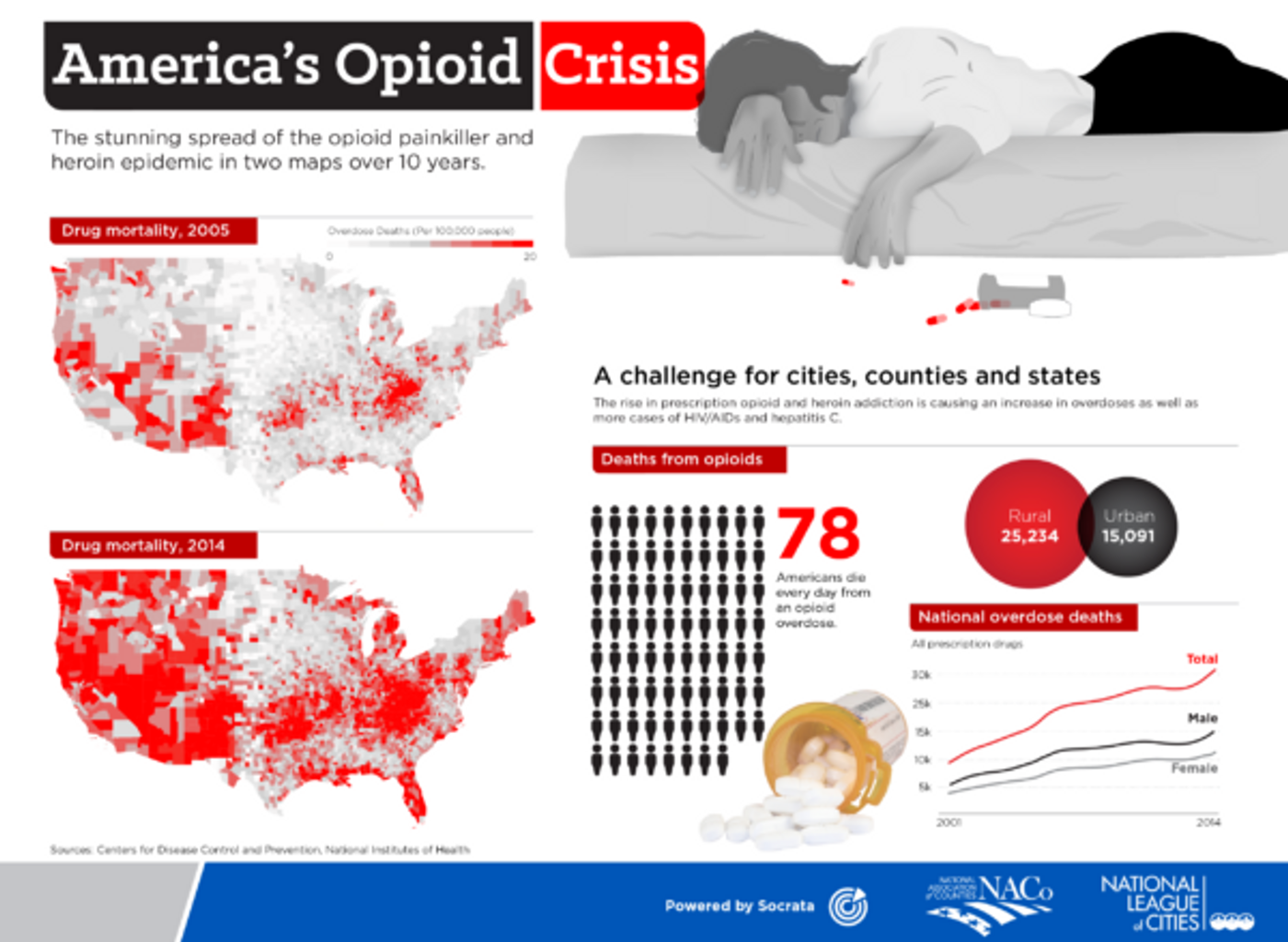Opioid Crisis: How Can Chemistry Community Help?
American opioid crisis statistics. Credit: Socrata
The United States is grappling with one of the worst-ever drug crises. More than a thousand people a week die from opioid-related overdoses, and millions of more people suffer from opioid addiction. In 2016, opioid overdoses killed more than fifty-three thousand people, a sevenfold increase from 1999.
If numbers do not tell you enough of how bad the crisis is, what happened to Ross County, a small rural town of 77,000 people in Ohio, in 2016 might be able to provide you a better idea: 44 people died from overdosing or other opioid-related condition, 150 children were placed into state care due to parents with opioid addictions, and a huge amount of pressure was landed on the county’ finance.
The crisis has reached such a scale that, beyond the risks it poses to public health, it is becoming a drag on the economy and a threat to national security. Analysts say the problem started with the over-prescription of legal pain medications, like oxycodone, but note that it has intensified in recent years with an influx of cheap heroin and synthetic opioids, like fentanyl, supplied by foreign-based drug cartels.
The chemistry community has been actively involved in delivering relieving efforts through different approaches. The most recognizable move came more than 20 years ago. When Purdue Pharma announce the release of OxyContin, a so-called abuse-deterrent form of opioid, in 1996, they forever changed the landscape of pain treatment.
What is special about OxyContin is that it contains oxycodone, a semisynthetic opioid, and ingredients that would enable the gradual release of the drug. Purdue claimed that patients taking these pills had a less than 1% chance of becoming addicted.
In a recent statement on reducing the risky use of prescription drugs, a pharmaceuticals alliance and advocacy group calls abuse-deterrent opioids an important treatment option that can help prevent widespread misuse. With 15 abuse-deterrent opioids currently in late-stage clinical trials, it is hoped that the misuse of prescribed opioids can be largely curbed.
But the abuse-deterrent form of opioids is not fix-all. Their circulation in the market has caused an unforeseen consequence: abusers shift their behaviors. In a survey on two different reformulated opioids, researchers discovered that after the treatment of OxyContins, its use by snorting, injecting, or smoking went down by 48%. At the same time, oral misuse went up by 49%. In contrast, Opana ER another brand of abuse-deterrent opioid prompted a more nuanced shift: people reported a 54% decrease in snorting, an 86% decrease in smoking, but only a 14% decrease in injecting the drug. Oral misuse remained about the same. Based on information from follow-up interviews, the researchers suggest that making it harder to snort the drug pushes people toward injection.
The unsatisfactory outcome of the abuse-deterrent form of opioids have chemists to redirect their efforts to the pain and analgesia research and find better alternatives to opioids. What happens with opioids, especially in term of managing chronic pain, is that patients take these drugs for considerable periods of time and rapidly build up the tolerance to them. For them to get the same pain relief, they need to take higher doses. Then dangerous consequences follow, including respiratory depression, addiction, and accidental overdose-caused death.
Researchers are looking to move beyond opioids for safer, nonaddictive, and more effective treatments for pain. In their search, scientists are exploring a wide range of drug targets beyond the mu opioid receptors that oxycodone and other opioids bind to and trigger. These alternative targets include G protein-coupled receptors, ion channels, enzymes, and growth factors. While many of these avenues look promising, experts in the field caution that obstacles stand in the way of making a good treatment for chronic pain.
Another area where chemists can get involved is to help find a fast and safe method to identify opioid and other illicit substances for the law enforcement agencies. Suspected drug samples are either tested at the scene or in the lab. To help relieve that burden in the laboratory and prevent accidental exposure, rapid testing techniques to safely identify dangerous compounds are under development.
Before the opioid crisis, law enforcement officers who came across suspected drugs commonly conducted a field test by mixing small drug sample with test reagents in a sealed envelope. Not only are the kits subjective and easy to misinterpret, but the act of taking a sample now puts officers at risk for accidental exposure.
The push-button analysis is the ideal mode of testing the industry wish to pursue, for the fast and accurate analysis for street drugs. Many instrument companies have been updating and adapting handheld Raman spectrometers, to identify illicit drugs. Raman spectroscopy is used in chemistry to identify molecules by examining the vibrational frequencies specific to a molecule’s chemical bonds and symmetry. They are perfect for detecting explosives for hazmat teams and bomb squads. They collect spectra produced when laser light scatters from molecules in the sample, and they match the spectra to those in a built-in library for various drugs, analogs, drug precursors, and cutting agents.
Given the complexity of the crisis, any changes and solution may create a cascading effect, good or bad. The society needs to tackle this with a system-wide approach, involving every sector and everybody.
Why Is There an Opioid Crisis? Credit: SciShow
Source: C&EN









